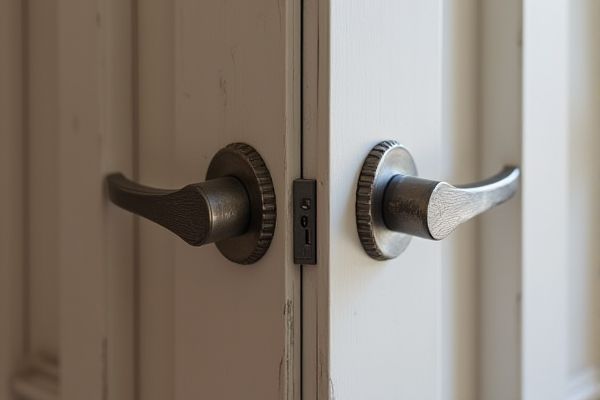
Integrated handles offer a sleek, minimalist look by blending seamlessly with the design surface, enhancing both aesthetics and functionality in modern cabinetry. Explore the article to discover how your choice between integrated and external handles can transform your space.
Table of Comparison
| Feature | Integrated Handles | External Handles |
|---|---|---|
| Design | Built into door or drawer surface | Attached externally, protruding from surface |
| Aesthetics | Sleek, minimalist look | Varied styles, more decorative options |
| Installation | Requires precise manufacturing | Easy to install or replace |
| Maintenance | Easy to clean, no gaps | Can accumulate dirt around handle base |
| Durability | Less prone to damage, integrated strength | Prone to loosening or damage over time |
| Cost | Higher initial manufacturing cost | Generally lower cost, more affordable |
| Customization | Limited to design phase | Flexible; easy to upgrade or change |
Introduction to Handle Design in Products
Integrated handles seamlessly blend into a product's structure, enhancing aesthetics and reducing material use while maintaining functionality. External handles protrude from the product surface, offering ergonomic grip and easy accessibility at the cost of increased manufacturing complexity. Handle design in products balances user interaction, durability, and visual appeal to optimize overall performance and user experience.
Defining Integrated Handles
Integrated handles are built directly into a product's surface, offering a seamless and streamlined design that enhances both aesthetics and functionality. Unlike external handles that protrude, integrated handles minimize snagging and provide a cleaner look, ideal for modern cabinetry and furniture. Your choice of integrated handles can improve space efficiency while maintaining ergonomic ease of use.
What Are External Handles?
External handles are protruding hardware attached to doors or cabinets, designed for easy gripping and pulling. They often provide a traditional or decorative look and are available in various shapes, materials, and finishes to complement interior design. Your choice between external and integrated handles depends on functionality preferences and aesthetic goals.
Aesthetic Differences: Integrated vs External
Integrated handles offer a sleek, minimalist aesthetic by seamlessly blending into the design of doors or cabinets, enhancing modern interior styles with clean lines and a flush surface. External handles, in contrast, provide a more traditional or decorative appearance, often protruding from the surface to create visible accents that can complement various design themes. The choice between integrated and external handles significantly affects the visual impact, with integrated solutions promoting subtle elegance and external handles emphasizing ornamental or functional prominence.
Functional Benefits of Integrated Handles
Integrated handles provide streamlined functionality by seamlessly blending with the furniture surface, which reduces dirt accumulation and enhances ease of cleaning. Their design promotes effortless grip and operation, minimizing hand strain during regular use and increasing overall durability compared to protruding external handles. This integration also optimizes space, making them ideal for compact environments where maximizing surface area is crucial.
Functional Advantages of External Handles
External handles offer superior accessibility by providing a more substantial grip surface, facilitating ease of use for individuals with limited hand strength or dexterity. They enhance durability through robust materials and construction, often supporting heavier loads and frequent use without compromising functionality. External handles also simplify repairs and replacements, reducing maintenance time and costs compared to integrated handle designs.
Durability and Maintenance Considerations
Integrated handles offer superior durability due to their seamless design, reducing the risk of loosening or breakage over time compared to external handles that are attached with screws or bolts. Maintenance is simplified with integrated handles, as there are fewer crevices where dirt and grime can accumulate, and no hardware to tighten or replace. External handles may require regular inspection and tightening to prevent wear, increasing long-term maintenance efforts.
Ergonomics and User Experience
Integrated handles offer a seamless design that enhances ergonomics by fitting naturally in the user's hand, reducing strain during repetitive use. External handles provide a more pronounced grip, allowing for easier control and leverage, which can improve user experience in heavy-duty tasks. Choosing between the two depends on task demands, with integrated handles favored for sleek aesthetics and lighter tasks, while external handles excel in comfort and functionality for prolonged or intensive use.
Cost Implications: Manufacturing and Installation
Integrated handles often reduce manufacturing costs by streamlining assembly processes and lowering material usage compared to external handles, which require additional components and fastening methods. Installation time is typically shorter for integrated handles, minimizing labor expenses, whereas external handles can increase installation complexity and cost due to alignment and hardware requirements. You can achieve overall savings by selecting integrated handles when optimizing for both production efficiency and installation budget.
Choosing the Right Handle Type: Key Considerations
Choosing the right handle type involves evaluating design aesthetics, functionality, and space optimization; integrated handles offer a sleek, minimalist appearance and easy cleaning, ideal for modern kitchens and tight spaces. External handles provide better grip and leverage, making them suitable for heavier drawers or doors requiring more force. Material durability, ergonomic comfort, and compatibility with door dimensions play crucial roles in selecting between integrated and external handles.
 homyna.com
homyna.com